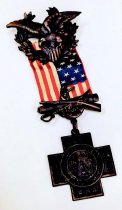Search Term Record
Metadata
Name |
Eagle |
Number of Archive records |
1 |
Number of Library records |
0 |
Number of Object records |
1 |
Number of Photo records |
0 |
Related Records
-
A Spanish American War Medal awarded to Edward Miller
A Spanish American War Medal awarded to Edward Miller. At the tope of the medal is an eagle in a wreath, followed by a ribbon depicting the American Flag and then a cross at the bottom which reads and various points: Cuba, Philipines, Puerto Rico and USA
Record Type: Object

-

